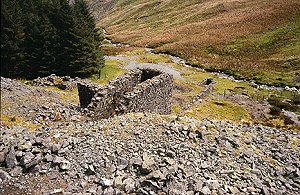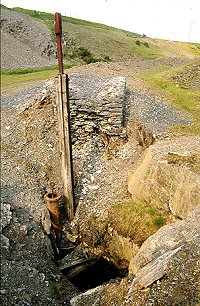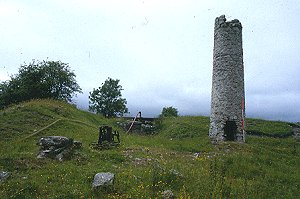
Cymraeg / English

|
Back Home |

|
Projects index |

|
Mines index |

|
CBA Publication |
Clwyd-Powys Metal Mines Survey
Powys Metal Mines Survey
Between May 1992 and August 1993, CPAT carried out a rapid survey of all of the non-ferrous metal mines (predominantly lead), phosphate mines and some of the more significant locatable trials, in Powys. The purpose of this work was to assess their present state of preservation, with a view to promoting better management and conservation of remains both above and below the ground, and to enhance CPAT's Regional Sites and Monuments Record. The survey entailed a rapid field appraisal of the surviving remains and an examination of documentary evidence gleaned from maps, mine plans, leases and prospectuses (held in the National Library of Wales, Aberystwyth and County Record Offices). This was accompanied by limited aerial photographic survey (carried out by Chris Musson formerly of the Royal Commission on Ancient and Historical Monuments of Wales - RCAHMW) and followed up by EDM ground survey of selected sites. Financial assistance for the initial survey was provided by Powys County Council, with additional support for the later stages coming from Cadw and RCAHMW.
Right: Nant-yr-Eira, Plynlimon. 19th-century mine crusher house and dressing area. © CPAT CS92/15/24
For the Powys ore field, located in the extreme west of the county in the Plynlimon uplands, a great deal of historical research had previously been carried out, but overall surveys of the surviving physical evidence had not been attempted. Powys' mining landscapes, like those elsewhere, have become increasingly vulnerable to reclamation schemes and the progressive march of forestry and agriculture, and this survey aimed to identify, and attempt to resolve, both active and potential threats to the remaining sites.
The earliest dated evidence of mining in Powys comes from the Nant-Yr-Eira mine, Plynlimon, where charcoal samples from the tips were dated to the late Bronze Age. In Powys, at Llanymynech Hill on the Shropshire border, early mining probably dates to the late Iron Age and first two centuries of the Roman period. Medieval mining is, as yet, poorly represented in Powys and is only positively identified in documentary sources, mentioning activity at Llanymynech. A grant of land to the Cistercian Monastery of Strata Marcella in 1198 includes rights 'above and below land' suggesting that the monks had an interest in lead mining in this area. Further work is needed here.
Post-medieval mining was stimulated by the interest and financial speculation of the Society of Mines Royal and Company of Mine Adventurers. Rapid development of mines in Powys followed with most receiving some attention from exploitation of the rich lead and copper sources. Technological improvements in driving deep adits and shafts only really took effect in the 18th-century with new pumping apparatus at some of the larger mines powered by hydraulic methods. Although steam pumping and winding engines had been invented by the 1750s, prohibitive costs of installation and fuelling meant that they did not appear in Powys until the 1850s.

Left: Part of a plan of Craig-y-Mwyn mine, produced during the Powys metal mines ground survey in 1994
The boom period of mining in Powys was the 19th-century. Steam powered engines first appeared at the Dyfngwm and Abergwesyn mines in Plynlimon. By the 1870s they are a common feature on many of the largest mines. Mechanisation of all of the extractive and processing stages rapidly developed as the century progressed. Invention of new apparatus for processing lead to produce a concentrate was particularly prolific in the second half of the century and has left a rich heritage of frequently unique structures on the largest mine sites. During the 1870s the mine at Van, near Llanidloes, had the distinction of being the most productive lead mine in Europe and employed state-of-the-art machinery. Recent archaeological work has revealed and preserved some of the unique structures at Van.
Metal mining in Powys declined rapidly during the late 1870s due to cheaper foreign imports, and the market never recovered enough to make mining in Powys financially viable. By 1921 the industry had completely collapsed.
Index to mines listed in the Powys Survey
Clwyd Metal Mines Survey
Between May and December 1993, CPAT carried out a rapid survey of all of the non-ferrous metal mines and trials, in Clwyd. As with the earlier Powys Metal Mines Survey, the intention was to provide a summary of the surviving physical evidence of mines, rather than a definitive history or interpretation of the industry. The work aimed to assess their present state of preservation, with a view to promoting better management and conservation of remains both above and below the ground, and to enhance CPAT's Regional Sites and Monuments Record. The survey entailed a rapid field appraisal of the surviving remains and an examination of documentary evidence gleaned from maps, mine plans, leases and prospectuses (held in the National Library of Wales, Aberystwyth and County Record Offices). This was accompanied by aerial photographic survey (carried out by Chris Musson formerly of the Royal Commission on Ancient and Historical Monuments of Wales - RCAHMW) and followed up by EDM ground survey of selected sites. Funding and other support for the work came from Cadw, Clwyd County Council and RCAHMW.
Right: Dylife Mine, Plynlimon. Llechwedd Ddu Shaft and pump rod support. © CPAT CS92/19/34
The archaeological potential of mining sites in Clwyd has previously had little study, and it has been difficult to appreciate the extent or nature of the surviving archaeology relating to these sites. The survey aimed to identify, and attempt to resolve, both active and potential threats to the remaining sites, which as elsewhere are under pressure from reclamation schemes and agricultural land improvements. The survey also produced specific conservation and management guidance for planners and others involved in promoting landscape change, in an attempt to minimise future damage to this vulnerable resource.
Metal mines in the region were probably in existence from the Iron Age. The close proximity of mineral veins to some hillforts hints at the recovery and working of ore before the Roman period. It is claimed that a large number of mines were worked for lead and silver by the Romans from 58 AD, although there is little direct evidence for this. Documentary sources provided clues to the importance of medieval mining in Clwyd, such as the reference to Edward I sending miners from Minera (near Wrexham) to Cornwall to help in the mining of tin in the late thirteenth century. Unfortunately, large-scale 19th-century mining operations seem to have obliterated most surface evidence of earlier workings.
The Quaker Company were pioneers of the lead mining in Clwyd from the late 17th century until 1792; their excellent records provide documentary evidence of technological changes in the industry in the 18th century. Improvements in technology and drainage allowed deeper shafts and the location of richer veins. The large-scale working of these rich areas in the 18th and 19th centuries has created visually striking landscapes of great historic interest.

Left: Bog East Mine, Llanarmon. This lead/silver mine began working in 1873 and was worked by the Llanarmon District Mining Company until 1913. © CPAT CS93/61/19
The structural remains recorded by this survey largely, but by no means exclusively, relate to 19th-century workings. The expansion of the industry at that time led to the disappearance of small mining ventures and the formation of large-scale mining companies. Large drainage tunnels were also constructed in 1818 and 1896 to drain the mines of Halkyn Mountain, the Holywell area and eventually the Mold and Llanarmon Mines. Towards the end of the 19th century mining activity in Clwyd declined due to foreign imports, although during the 1914-18 war, the Ministry of Munitions loaned money to stimulate the industry, which continued to work intermittently until the 1960s.
Index to mines listed in the Clwyd Survey
The Council for British Archaeology has recently published a research report about the Clwyd Powys Archaeological Trust's Metal Mines Survey.
Follow this link to find out more . . .
Sources
Jones, N W and Frost, P - 1995, Powys Metal Mines Ground Survey 1994, CPAT Report no. 111.1
Jones, N W and Frost, P - 1996, Clwyd Metal Mines Ground Survey 1995, CPAT Report no. 165
Walters, M - 1994, Powys Metal Mines Survey 1993, CPAT Report no. 89
Privacy and cookies